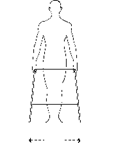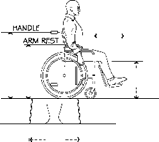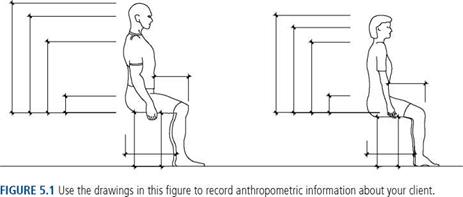The first thing you want to know is who uses the bathroom? Gather information about the users of the bathroom, their physical profiles, and any specialized needs they have. For instance, who are the primary users of the bathroom? How old are they? How tall are they?
You will want to collect anthropometric (human measurement) information about your individual clients. This is especially important if your clients have any physical limitations or concerns about access to bathroom activities.
Review chapter 4, "Human Factors and Universal Design Foundation," to learn more about the importance of anthropometry and ergonomic design. Form 1: Getting to Know Your Client, is a tool you can use to collect anthropometric information about your client. Form 1 is also designed to help you collect information about any of your client’s special needs with respect to the bathroom space. For example, do any of the users have special physical needs or situations? Do any of them require a mobility aid, such as a wheelchair or cane?
In addition to the anthropometric information and other special needs, you need to learn a little about your client’s attitudes toward bathroom use and activities. It will be important to determine issues such as: Will more than one person be using the bathroom at the same time? What are they comfortable doing in a shared bathroom space? Form 1 can assist you in gathering this information.
![]()
Form 1: Getting to Know Your Client
This form collects information about your clients. Use the parts that are appropriate to your design project. A custom design project, or a client with special needs, may require more detailed information.
|
1. Users of the bathroom: name: |
Age: |
|
|
Height: |
Weight: |
Handedness: П Right П Left |
|
Special needs or concerns: |
name:____________________________________________________________________________________________ Age:_______________________
Height:_____________________________________ Weight:_____________________________________ Handedness: П Right П Left
Special needs or concerns:____________________________________________________________________________________________________
name:____________________________________________________________________________________________ Age:_______________________
Height:_____________________________________ Weight:_____________________________________ Handedness: П Right П Left
Special needs or concerns:____________________________________________________________________________________________________
|
name:____________________________________________________________________________________________ Age:
|
2. Anthropometric information (See Figure 5.1)
3. Reach and grasp profile (See Figure 5.2)
4. Physical profile
Physical characteristic(s) affecting activities in the bathroom:
A. Sight:
Do you wear glasses for: П Reading П distance Are you taking medications that affect your sight?
Are you sensitive to light?
B. Hearing:
What issues regarding your hearing will affect your activities in the bathroom?
C. Tactile/touch:
Can you feel hot and cold?
D. Taste/smell:
What issues regarding your sense of taste or smell will affect your activities in the bathroom?
E. Strength and function:
What can you lift? Carry?
Do you have more strength on one side than the other?
|
|
|
2. ANTHROPOMETRIC INFORMATION |
 |
|
|
Form 1: Getting to Know Your Client (continued)
Do you use both hands fully? Palms only?
How is your grip?
Left side? Right side?
F. Balance, mobility, and assistance:
How is your balance: Standing? Bending?
Does your mobility or balance vary by time of day?
Does an assistant help you: Sometimes? All the time?
What adaptive equipment do you use?
G. Prognosis: is your condition stable? is further deterioration anticipated? is improvement anticipated?
H. Other physical concerns: i. Special safety concerns:
5. Mobility Aids
 |
 |
 |
if a mobility aid, such as wheelchair, walker, or cane is used, it is important to collect information on the size of the mobility aid, as well as anthropometrical information about the client when using the mobility aid (Figure 5.3).
FIGURE 5.3 if appropriate to your client, use the drawings in this figure to record information about your client that includes a mobility aid,
6. Personal information about the bathroom
• Will more than one person be using the bathroom at the same time? How often?
• What types of bathroom activities can be done in a shared bathroom space?
• What types of bathroom activities need to be done in private?
• How important is auditory privacy? Are bathroom noises a problem?





